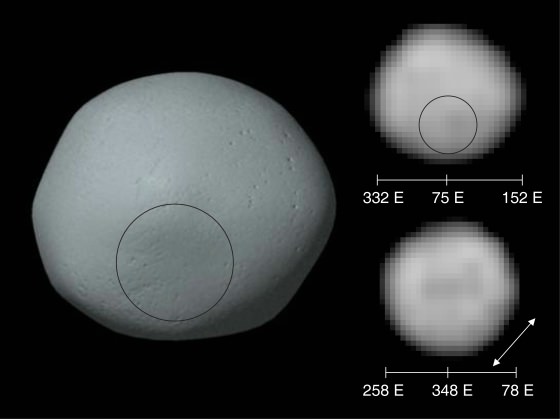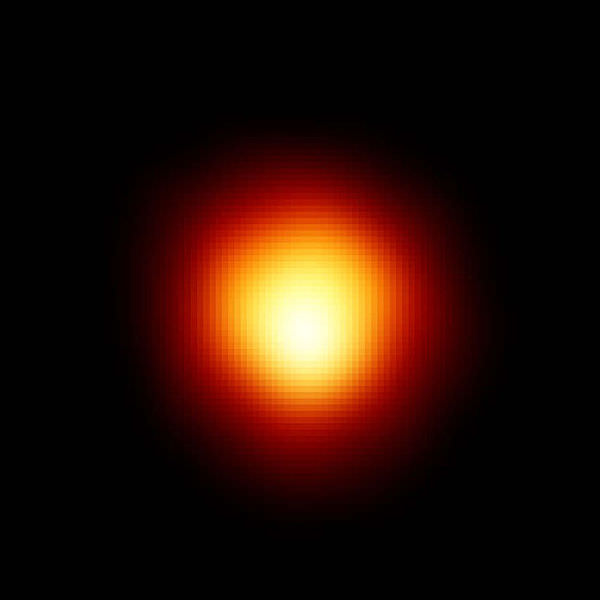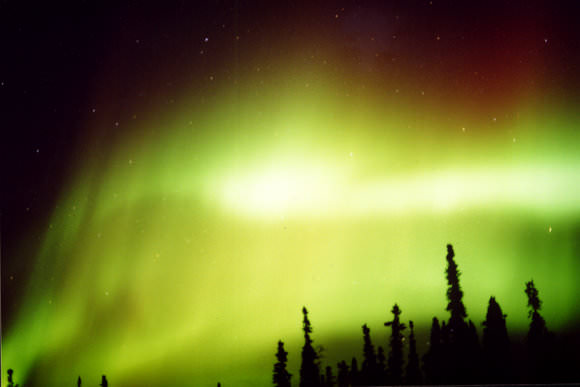Quick! Grab a pair of red and green 3-D glasses and slap them on to watch this great time lapse video of the Very Large Telescope at the Paranal Observatory, high in the Atacama Desert in Chile. It shows a complete night at the observatory, and you can see the four 8m telescopes and the four 1.8m telescopes of the VLT working, all in 3-D. The video comes from the handiwork of astrophotographer and head Optics Engineer on the VLT, Stéphane Guisard. If that name sounds familiar, Stéphane has recently been working with ESO and fellow astrophotographer Serge Brunier on the GigaGalaxy Zoom project. Click this link to go directly to GigaGalaxy Zoom, or read one of our previous articles about them here. It was made by using two cameras taking pictures simultaneously, which were combined to create an anaglyph time lapse movie. Two notes about the movie: the telescopes and domes were lit by the moonlight, and the International Space Station crosses the sky during the very first seconds of the movie.
Continue reading “A Very Large 3-D Movie”
Asteroid Pallas is Also a Protoplanet
[/caption]
Some objects in the solar system are in a “gray area,” and can be classified under more than one heading. Add the asteroid Pallas to that group. New close-up images of Pallas from the Hubble Space Telescope reveal that the second largest asteroid in the solar system appears to be a protoplanet, as well.
Britney E. Schmidt, a UCLA doctoral student, led a team of researchers to create a 3D model of the 600km-wide rock which lies within the main asteroid belt between the orbits of Jupiter and Mars.
With the Hubble images, Schmidt and her colleagues were able to take new measurements of Pallas’ size and shape. What they found showed that Pallas wasn’t just a big rock made of hydrated silicate and ice.
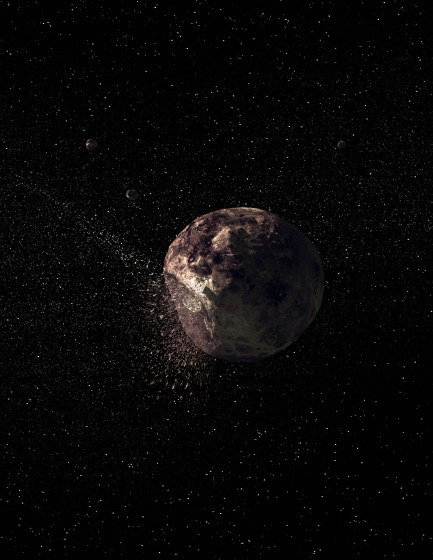
“It was incredibly exciting to have this new perspective on an object that is really interesting and hadn’t been observed by Hubble at high resolution,” Schmidt said of the first high-resolution images of Pallas, which is believed to have been intact since its formation, most likely within a few million years of the birth of our solar system.
“We were trying to understand not only the object, but how the solar system formed,” Schmidt said. “We think of these large asteroids not only as the building blocks of planets but as a chance to look at planet formation frozen in time.”
Visible in the Hubble images were areas of dark and light on Pallus’ surface, indicating that the water-rich body might have undergone an internal change in the same way planets do.
“That’s what makes it more like a planet — the color variation and the round shape are very important as far as understanding, is this a dynamic object or has it been exactly the same since it’s been formed?” Schmidt said. “We think it’s probably a dynamic object.”
For the first time, a large depression was also seen on Pallas. They were unable to determine if it was a crater, but the depression did suggest something else important: that it could have led to Pallas’ small family of asteroids orbiting in space.
“It’s interesting, because there are very few large, intact asteroids left,” Schmidt said. “There were probably many more. Most have been broken up completely. It’s an interesting chance to almost look into the object, at the layer underneath. It’s helping to unravel one of the big questions that we have about Pallas, why does it have this family?”
The massive body is unique, she said, partly because “its orbit is so much different from other asteroids. It’s highly inclined.”
“It was incredibly exciting to have this new perspective on an object that is really interesting and hadn’t been observed by Hubble at high resolution,” said Schmidt.
“When people think of asteroids, they think of ‘Star Wars’ or of tiny little rocks floating through space,” Schmidt said. “But some of these have been really physically dynamic. Around 5 million years after the formation of the solar system, Pallas was probably doing something kind of interesting.”
Source: PhysOrg
What is an Event Horizon?

The event horizon of a black hole is the boundary (‘horizon’) between its ‘outside’ and its ‘inside’; those outside cannot know anything about things (‘events’) which happen inside.
What an event horizon is – its behavior – is described by applying the equations of Einstein’s theory of General Relativity (GR); as of today, the theoretical predictions concerning event horizons can be tested in only very limited ways. Why? Because we don’t have any black holes we can study up close and personal (so to speak) … which is perhaps a very good thing!
If the black hole is not rotating, its event horizon has the shape of a sphere; it’s like a 2D surface over a 3D ball. Except, not quite; GR is a theory about spacetime, and contains many counter-intuitive aspects. For example, if you fall freely into a black hole (one sufficiently massive that tidal forces don’t rip you to pieces and smear you into a plastic-wrap thin layer of goo, a supermassive black hole for example), you won’t notice a thing as you pass through the event horizon … and that’s because it’s not the event horizon to you! In other words, the location of the event horizon of a black hole depends upon who is doing the observing (that word ‘relativity’ really does some heavy lifting, if you’ll excuse the pun), and as you fall (freely) into a black hole, the event horizon is always ahead of you.
You’ll often read that the event horizon is where the escape velocity is c, the speed of light; that’s a not-too-bad description, but it’s better to say that the path of any ray of light, inside the event horizon, can never make it beyond that horizon.
If you watch – from afar! – something fall into a black hole, you’ll see that it gets closer and closer, and light from it gets redder and redder (increasingly redshifted), but it never actually reaches the event horizon. And that’s the closest we’ve come to testing the theoretical predictions of event horizons; we see stuff – mass ripped from the normal star in a binary, say – heading down into its massive companion, but we never see any sign of it hitting anything (like a solid surface). In the next decade or so it might be possible to study event horizons much more closely, by imaging SgrA* (the supermassive black hole – SMBH – at the center of our galaxy), or the SMBH in M87, with extremely high resolution.
The Universe Today article Black Hole Event Horizon Measured is about just this kind of black hole-normal star binary, Black Hole Flares as it Gobbles Matter is about observations of matter falling into a SMBH, and Maximizing Survival Time Inside the Event Horizon of a Black Hole describes some of the weird things about event horizons.
There’s more on event horizons in the Astronomy Cast Relativity, Relativity and More Relativity episode, and the Black Hole Surfaces one.
Sources: NASA Science, NASA Imagine the Universe
Betelgeuse
[/caption]
Betelgeuse is the ninth brightest star in the sky, and the second brightest in the constellation of Orion (it’s the red one, on the opposite side of the Belt from Rigel, which is the blue one, and the brightest).
With a mass of some 20 sols (= the mass of 20 Suns), Betelgeuse is evolving rapidly, even though it’s only a few million years old. It’s now a red supergiant, burning helium in a shell, and (very likely) burning carbon in another shell (closer to the nucleus), and (possibly) oxygen, silicon, and sulfur in other nested shells (like Russian dolls).
Betelgeuse is enormous … if it were where the Sun is, all four inner planets would be inside it! Because it’s so big, and is only approx 640 light-years away, Betelgeuse appears to about 1/20 of an arcsecond in size; this made it an ideal target for optical interferometry. And so it was that in 1920 Michelson and Pease used the 100″ Mt Wilson telescope, with a 20 m interferometer attached to the front, to measure Betelgeuse’s diameter.
The Hubble Space Telescope imaged Betelgeuse directly, in 1995, in the ultraviolet (see above). Why the UV? Because ground-based telescopes can’t make such observations, and because the Hubble’s resolution is greatest in the UV.
Since the 1920s Betelgeuse has been observed, from the ground, by many different optical interferometers, at many wavelengths. Its diameter varies somewhat, as does its brightness (Herschel is perhaps the first astronomer to describe its variability, in 1836). It also has ‘hotspots’, which are ginormous.
Betelgeuse is also shedding mass in giant plumes that stretch to over six times its diameter. Although these plumes will certainly cause it to ‘slim down’, they won’t be enough to stop its core turning to iron (when the silicon there is exhausted, if it hasn’t already done so). Not long afterwards, perhaps within the next thousand years or so, Betelgeuse will go supernova … making it the brightest and most spectacular supernova visible from Earth in perhaps a million years. Fortunately, because we are not looking directly down on its pole, when Betelgeuse does go bang, we won’t be fried by a gamma ray burst (GRB) which may occur (while a core collapse supernova can cause one kind of GRB, it is not yet known if all such supernovae produce GRBs; in any case, such a GRB is one of a pair of jets which rip through the poles of the dying star).
AAVSO has an excellent article on Betelgeuse, and COAST’s (Cambridge Optical Aperture Synthesis Telescope) webpage on its observations of Betelgeuse gives a good summary of one interferometric technique (and some great images too!).
Universe Today has many stories on just about every aspect of Betelgeuse, from its varying size (The Curious Case of the Shrinking Star), the bubbles it’s blowing and its plumes (Closest Ever Look at Betelgeuse Reveals its Fiery Secret), featured in What’s Up This Week, to the bow shock it creates in the interstellar medium (The Bow Shock of Betelgeuse Revealed).
Astronomy Cast’s The Life of Other Stars is a whole episode on the evolution of stars other than the Sun.
References:
http://en.wikipedia.org/wiki/Betelgeuse
http://www.solstation.com/x-objects/betelgeuse.htm
What is the Aurora Borealis?
[/caption]
The aurora (plural aurorae) borealis has many other names: northern lights, northern polar lights, polar lights, and more. An aurora borealis is light seen in the sky, nearly always at night, in the northern hemisphere, commonly green but also red and (rarely) other colors; often in the shape of curtains, sheets, or a diffuse glow (when seen from the ground). Northern lights are most often seen at high latitudes – Alaska, Canada, northern Scandinavia, Greenland, Siberia, and Iceland – and during maxima in the solar cycle.
Aurora australis – southern lights – is the corresponding southern hemisphere phenomenon.
Seeing a bright auroral display may be on your list of ‘things to see before I die’! Yep, they are nature’s light show par excellence.
Aurora borealis occur in the Earth’s ionosphere, and result from collisions between energetic electrons (sometimes also protons, and even heavier charged particles) and atoms and molecules in the upper atmosphere. The ultimate origin of the energy which powers the aurora borealis is the Sun – via the solar wind – and the Earth’s magnetic field. Interactions between the solar wind (which carries its own tangled magnetic fields) and the Earth’s magnetic field may cause electrons (and other particles) to be trapped and accelerated; those particles which do not escape ‘downstream’ to the magnetic tail ‘touch down’ in the atmosphere, close to the north magnetic pole.
The different colors come from different atoms or ions; green and red from atomic oxygen, nitrogen ions and molecules make some pinkish-reds and blue-violet; purple is the appearance of combined colors from nitrogen ions and helium; neon produces the very rare orange. The ionosphere is home to most aurorae borealis, with 100-300 km being typical (this is where green is usually seen, with red at the top); however, some particularly energetic particles penetrate much deeper into the atmosphere, down to perhaps 80 km or lower (purple often comes from here).
Viewed from space, when the northern lights are intense they appear as a ring (an oval actually), the auroral zone, with the north magnetic pole near the center.
The University of Alaska Fairbanks’ Geophysical Institute has a good FAQ on the aurora borealis.
Magnetic fields plus solar wind … so you’d expect aurorae on Jupiter and Saturn, right? And auroral displays around the magnetic poles of these planets are now well documented. Aurorae have also been imaged on Venus, Mars, Uranus, Neptune, and even Io.
Some Universe Today stories on aurorae – borealis, australis, … and extra-terrestrial: What are the Northern Lights?, Aurora Reports from Around the World, Behind the Power and Beauty of the Northern Lights, Northern & Southern Aurorae Are Siblings, But Not Twins, Two Rockets Fly Through Auroral Arc, Chandra Looks at the Earth’s Aurora, First Aurora Seen on Mars, and Saturn’s “Dualing” Aurorae.
Now Watch This: Saturn Aurora Movie
Wow! This is really neat! We’ve long known that Saturn has aurorae, and the Cassini team recently took a series of images to see if they could catch an aurora in action near Saturn’s north pole. As always, the folks at UnmannedSpaceflight.com are always on the lookout for the latest images being beamed back to Earth, and one of the UMSFer’s, Astro0, saw this image series, realized what the Cassini team was trying to do, and used the images to put together this movie. You’ll see Saturn’s limb, moving stars, streaks that are likely cosmic ray hits, and flaring aurorae, or “curtains of light” that can sometimes rise 1,200 miles (2,000 km) above the cloud tops near Saturn’s poles. Astronomers say that while aurorae on Earth shine for a few hours at most, on Saturn they can last for days. Additionally, if you were on Saturn, the aurora would look like a faint red glow. Most of the energy in Saturn’s aurora is not in the form of visible light, though and instead they mostly glow in ultraviolet (UV) or infrared wavelengths. Read our previous article about the infrared aurorae at Saturn.
Thanks Astro0, (with H/T to Emily Lakdawalla)!
Greenwich Mean Time
[/caption]
Greenwich Mean Time was formulated in the 1800’s in order to deal with the confusion that existed when each country decided its own solar time. This was especially important with the increase in traveling and train schedules. In 1884, at the Meridian Conference, 27 countries decided to implement a system that is practically the same one that we have today. They based their system on one formulated by a Canadian railway planner and engineer, Sir Sanford Fleming.
In this system, there are 24 lines that go from the North to the South called meridians of longitude. They are spaced 15° apart. The first line, known as the prime meridian, is located in Greenwich, England. It is 0° longitude. Greenwich Mean Time (GMT) refers to solar mean time at the Royal Observatory in Greenwich, England. Solar mean time is calculated using the angle of the mean Sun – a fictional Sun used to compute time. Since Britain was an advanced maritime nation, they had long used Greenwich as a point of longitude to calculate their longitude in relation to the Greenwich meridian. Due to its long history, the world decided to accept it as the prime meridian as well.
Different countries have legally defined their local time in reference to Greenwich Mean Time. These countries include the United Kingdom, Belgium, the Republic of Ireland, and Canada. Although GMT is used all year round in Iceland, it is only used during the winter in Ireland and the UK. During the summer, British Summer Time (BST) is used. This is also known as Greenwich Daylight Savings Time (GDT), which corresponds to daylights savings time in the United States. The Greenwich Mean Time is also known as the Universal Time (UT).
The issue of time zones is made more complicated because the zones are not always split along the longitudinal lines. They are also divided along political boundaries. This means that although it may be one time in the one country, if you head north or south while staying in the same longitude, the time may change.
GMT is used for a variety of things. For example, many emails between people from different time zones include a reference to GMT, explaining how many hours that person’s time zone is from GMT. On the International Space Station, they use GMT. The US Government National Weather Service and the Weather Channel both use weather maps that use GMT. These are just a few of many ways that the GMT is used today.
Universe Today has a number of articles on interesting facts about Earth and how long a day on Earth is.
If you are looking for more information, you should check out what is GMT and Greenwich Mean Time.
Astronomy Cast has an episode on Earth.
Evening Star
[/caption]
Venus is also known as the evening star. It was given that name by ancient civilizations, such as the Greeks and Egyptians, who saw it in the sky. The planet was eventually named after the Roman goddess of love because of its beauty. Many ancient cultures have his planet with love and womanhood. Venus has been an important object in a number of different cultures including to the Babylonians and Mayans. The Mayans even used the movement of the planet to help create their complex calendar.
Venus is close to the Earth as well as the Sun. As soon as the Sun sets and it gets dark enough, Venus can often be seen in the sky. Because it seems In addition to being known as the evening star, Venus was also called the morning star because it could be seen for a few hours before the Sun grew too bright. The planet actually becomes brightest before the Sun rises or just after sunset. The ancient civilizations thought that the morning star and the evening star were separate celestial bodies. Pythagoras, the famous Greek mathematician, is believed to be the first person to realize that the morning and evening stars were actually the same object – Venus.
The Egyptians had two names for the planets because they thought it was actually two stars. The morning star was called Tioumoutri, and the evening star was known as Ouaiti. The Greeks called the evenings star Hesperos, the “star of the evening.” The Greeks called the morning star, Phosphoros “the Bringer of Light,” or Eosphoros, “the Bringer of Dawn.”
Besides the Sun and Earth’s Moon, Venus is the brightest object in our Solar System. Its brightness is caused in part by the clouds of toxic gases that comprise its atmosphere. The sulfur dioxide and other elements in these clouds reflect light from the Sun causing the planet to shine.
Long after astronomers discovered that Venus was no longer the evening or morning star it has captivated the imagination of many. The swirling clouds that hid the surface of this shining planet from view were thought to shield a tropical paradise. Ironically, what many considered to be the most beautiful planet turned out to be a burning wasteland – the hottest planet in our Solar System. Another one of Venus’ many names is Earth’s twin because it is similar in size and mass to our own planet.
Universe Today has articles on the morning and evening star and the history of Venus.
For more information, you should take a look at Venus and an introduction to Venus.
Astronomy Cast has an episode on Venus.
References:
NASA History: Earth’s Sister and the Twilight Planet
NASA: Planets
Carnival of Space #124
This week’s Carnival of Space is over at We Are All In the Gutter (looking at the stars).
Click here to read the Carnival of Space #124.
And if you’re interested in looking back, here’s an archive to all the past Carnivals of Space. If you’ve got a space-related blog, you should really join the carnival. Just email an entry to [email protected], and the next host will link to it. It will help get awareness out there about your writing, help you meet others in the space community – and community is what blogging is all about. And if you really want to help out, let Fraser know if you can be a host, and he’ll schedule you into the calendar.
Finally, if you run a space-related blog, please post a link to the Carnival of Space. Help us get the word out.
New Hubble Release: Dramatic Galaxy Collision
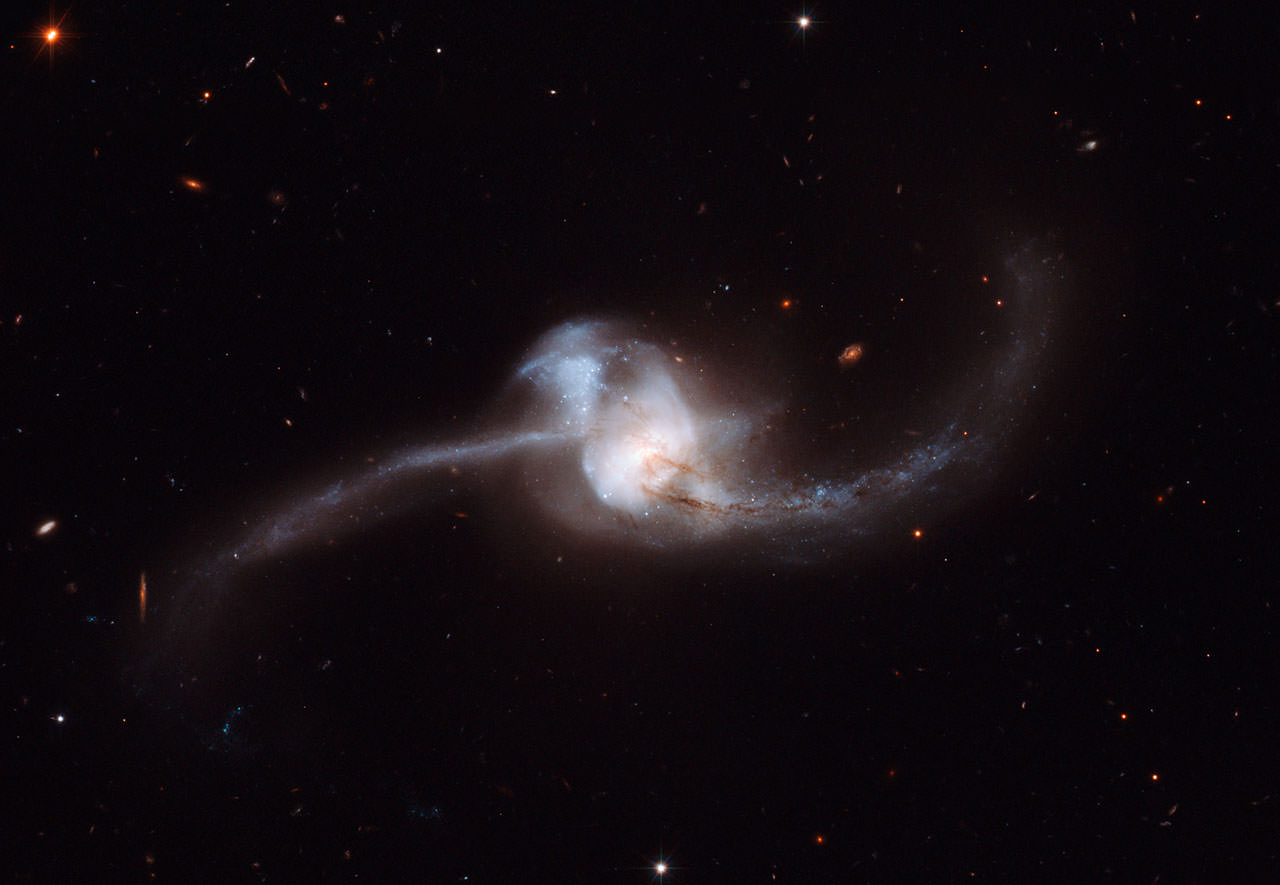
[/caption]
At first glance, this latest image release from Hubble appears to be one really bizarre-looking galaxy. But actually, this is a pair of spiral galaxies that resemble our own Milky Way smashing together at breakneck speeds. The centers have already merged into one nucleus, and the two tidal tails stretching out from the center are sparkling with active star formation, prompted by the exchange of mass and gases from the dramatic collision. This object, NGC 2623, or Arp 243, is about 250 million light-years away in the constellation of Cancer (the Crab), and is in the late stages of the merging process.
The prominent lower tail is richly populated with bright star clusters — 100 of them have been found in these observations. The large star clusters that the team has observed in the merged galaxy are brighter than the brightest clusters we see in our own vicinity. These star clusters may have formed as part of a loop of stretched material associated with the northern tail, or they may have formed from debris falling back onto the nucleus. In addition to this active star-forming region, both galactic arms harbor very young stars in the early stages of their evolutionary journey.
Watch this video for more information on NGC 2623:
Some mergers (including NGC 2623) can result in an active galactic nucleus, where one of the supermassive black holes found at the centers of the two original galaxies is stirred into action. Matter is pulled toward the black hole, forming an accretion disc. The energy released by the frenzied motion heats up the disc, causing it to emit across a wide swath of the electromagnetic spectrum.
NGC 2623 is so bright in the infrared that it belongs to the group of very luminous infrared galaxies (LIRG) and has been extensively studied as the part of the Great Observatories All-sky LIRG Survey (GOALS) project that combines data from Hubble, the Spitzer Space Telescope, Chandra X-ray Observatory and the Galaxy Evolution Explorer (GALEX). The combination of resources is helping astronomers characterize objects like active galactic nuclei and nuclear star formation by revealing what is unseen at visible wavelengths.
The data used for this color composite were actually taken in 2007 by the Advanced Camera for Surveys (ACS) aboard Hubble, but is just being released now, as a team of over 30 astronomers, led by Aaron S. Evans, recently published an overview paper, detailing the first results of the GOALS project. Observations from ESA’s X-ray Multi-Mirror Mission (XMM-Newton) telescope contributed to the astronomers’ understanding of NGC 2623.
NGC 2623 paper
GOALS Overview paper
GOALS website
Source: European Hubble website

